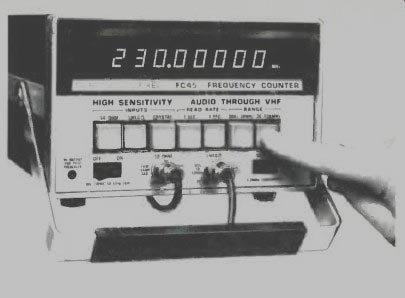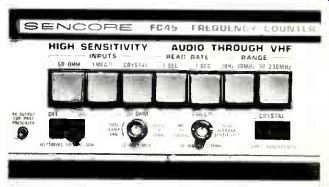By Carl Babcoke

Figure 1 The FC45 Sencore digital frequency counter has several unusual
features, including high-and low-resistance inputs, and coverage from
20 Hz to 230 MHz in two ranges. No external adjustments are needed to
obtain an accurate count.

Figure 2 Three pushbuttons are for input selection, two more select
the reading rate, and another two buttons select the range desired. At
the lower left is the power jack for the prescaler, and the crystal jack
is at the lower right. Two BNC connectors are provided for the inputs.
Each report about an item of electronic test equipment is based on examination and operation of the device in the ELECTRONIC SERVICING laboratory. Personal observations about the performance, and details of new and useful features are spotlighted, along with tips about using the equipment for best results.
Sencore FC45 Frequency Counter
Model FC45 digital frequency counter from Sencore (Figure 1) has no external adjustments, but it does have seven pushbuttons and two input jacks, plus the on/off switch.
These extra pushbuttons and jacks greatly increase the versatility of the instrument, permitting additional types of measurements.
FC45 Features Here are some important features of the Sencore FC45 counter:
The display has eight 0.5-inch red LED digits; Hz and MHz lights show the range that's in use; The decimal is placed automatically according to the push-button selected (although not mentioned in the instruction book, the internal circuit apparently selects the range giving best resolution); Both 1-megohm and 50-ohm inputs are provided; Either 0.1-second or 1-second update can be selected; Two ranges of frequency coverage are supplied; An external socket is provided for testing the fundamental frequency of crystals; The 50-ohm input has a 12-watt 50-ohm load, which can be used as the load for a CB transmitter; The counter can operate from either 120 VAC or 12 VDC; An oven maintains a constant temperature for the internal timing oscillator, to minimize calibration drift; Many accessories are available, including special probes; and, The input circuits protect against moderate overloads, and a fuse protects the 50-ohm input from massive overloads.
Frequency Ranges
Two ranges cover from 30 Hz to 30 MHz, and from 30 MHz to 230 MHz (see Figure 2 for the panel layout). Actually, the two ranges overlap, with the lower range useful to about 35 MHz, and the higher one operating down to about 10 MHz. Readings of the higher band are provided by a built-in 10-to-1 scaler.
The minimum amplitude of input voltage required for reliable counting varies with the frequency and type of input. Any input above 20 millivolts should give a reading, except at the extreme ends of the ranges where a stronger input is required. Refer to the charts in the instruction manual for the exact levels needed.
Input Resistances
Pushbuttons select either a 50-ohm or a 1-megohm input resistance. The 50-ohm input has an internal 12-watt dummy load rated at 12 watts, and it can be used as the test load of a CB transmitter. The frequency can be checked at the same time, or the 50-ohm input can function only as a load, while you check the frequency of another circuit by using the 1-megohm input.
For most other measurements, the 1-megohm input probably is better.
There is less undesirable loading of the circuit that's being tested.
However, a few square wave or pulse waveforms suffer ringing when they enter the 1-megohm input (because of the mismatch between cable and load). In such cases, the ringing will be counted as extra cycles, giving a wrong count. This can be prevented by using the 50-ohm input. Refer to the instruction manual for details.
Time-Base Frequency readings can be updated either every 1/10 second or once every second, depending on the resolution needed. Of course, all audio measurements should be made with the 1-second timebase.
The timebase also determines the accuracy of this (or any other) digital counter. The FC45 has a temperature-regulated oven for the crystal oscillator, to minimize the drift from changes of room temperature.
Specs call for a temperature stability from 0° to 40° Centigrade of only 1 part-per-million, following a 10-minute warmup. After 30 days of operation, the stability versus time should be about 2 PPM per year. Therefore, the total accuracy is ± the time base accuracy, ±1 count.
Accessories
A 39G112 direct/isolated (through 33 pF capacitor) probe is supplied with each FC45 counter. It is pictured in Figure 3. The "hot" lead is very handy for connecting to small wires (such as transistor leads), for it is spring loaded and completely insulated (except for the tiny hook). Also, a fused, DC-supply cable with plug for a cigarette lighter is furnished.
Optional
Useful, but not supplied with the FC45, are the 39G80 low-capacitance 10-to-1 probe, the NE206 noise-minimizer probe (not sent for testing, but it apparently gives different amounts of low-pass filtering to remove some types of noise from the input signal), a PL207 pickup loop for RF signals (Figure 4), and a PR47 prescaler. The prescaler can be operated from an FC45, or other types of counters.
PR47 10-to-1 Prescaler
The PR47 prescaler (Figure 5) is designed to be connected ahead of a digital frequency counter. It has a 10-to-1 divider circuit; therefore, the output frequency is 0.1 times the input frequency. The PR47 is rated for inputs up to 600 MHz, when used with a counter having a top frequency of 60 MHz.
Because there is no action except the divide-by-10 function, the accuracy depends on the counter. PR47 does not change the accuracy of the count.
External power of 7 to 10 volts DC is required for the prescaler. The FC45 has a 9-volt jack at the lower-left corner of the front panel for powering the PR47. However, the PR47 can be used with other counters by the addition of a PA202 AC adapter (not supplied). Input resistance is 50 ohms, to minimize cable ringing. The input is protected up to 3.5 volts RMS at 600 MHz input, or 7 volts RMS at low frequencies. Output amplitude is 1 volt PP. The sensitivity varies with frequency, but should not require more than 325 millivolts of input for dependable operation.
A PL207 RF loop and a 39G116 power cable are supplied with each PR47.
Comments
The Sencore FC45 is one of the few counters I've tested that correctly counted an audio signal, with the generator connected to the high-impedance input of the counter.
Also, the direct/isolated probe should allow operation with more circuits, and with far less chance of accidental shorts.
Another good idea is the RF loop. I obtained a reading of 3.579552 MHz by placing the loop over the reactance coil of an old color TV. In the same television, a reading of 15,734 Hz was shown when the loop was hung over the horizontal efficiency coil.
All counters give wild and in-accurate readings under certain conditions. The Sencore instruction manual illustrates them and gives the solutions. I advise that you study the manual thoroughly.
The Sencore model FC45 counter performed all tests perfectly, and should prove to be a reliable and versatile instrument.

Figure 3. A sliding switch in the 39G112 probe selects direct input,
or routes the input signal through a 33 pF capacitor.
Figure 4 The PL207 RF pickup is small so it can be slipped over coils. The offset handle permits easy location of the loop, even in crowded chassis.
This is an excellent method of obtaining a sample signal for the counter, without loading the circuit that's under test, or exposing the counter to excessive voltages.
Figure 5. The small prescaler PR47 Sencore permits a counter having an upper limit of 60 MHz to count up to 600 MHz. It has a divide-by-10 circuit.
The input is 50 ohms, and the signal should have a level between 300 millivolts and 3.5 volts.
(adapted from: Electronic Servicing magazine, Oct. 1977)
Also see: Reports from the Test Lab (Dec. 1977)